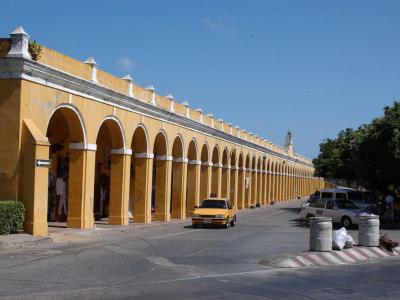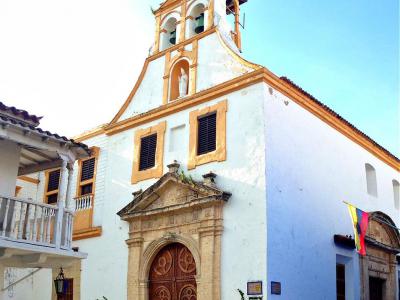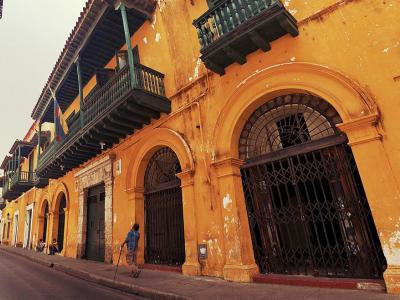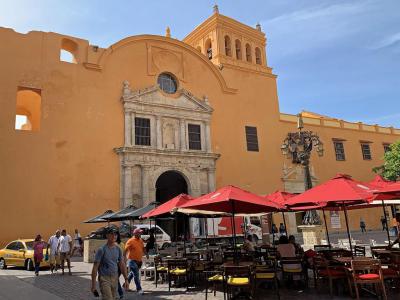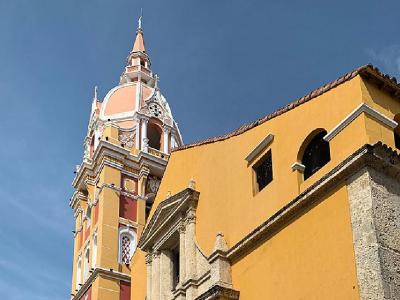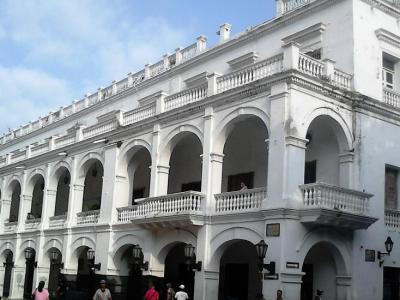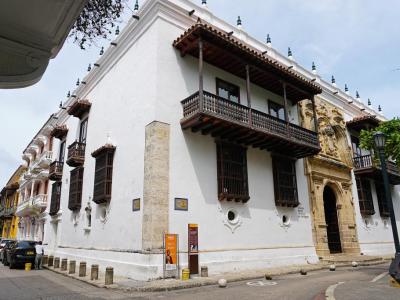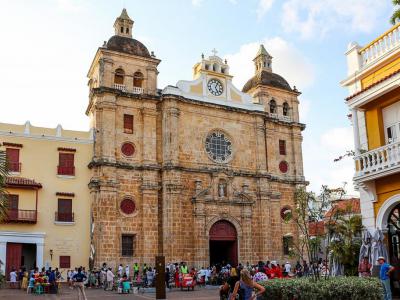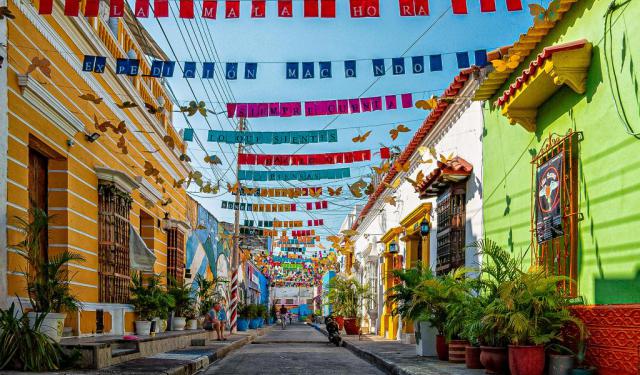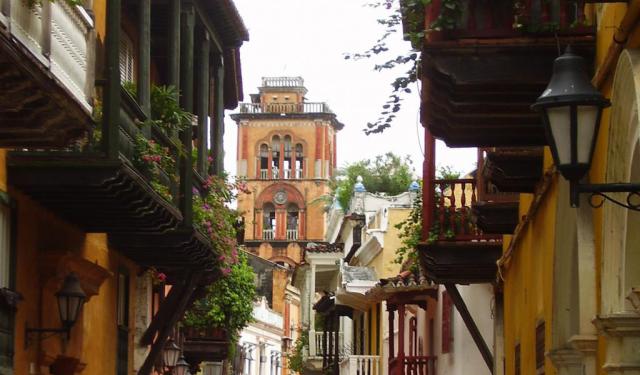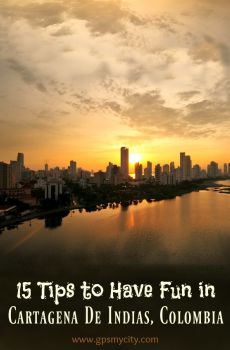Colonial Architecture Walk (Self Guided), Cartagena
Visiting Cartagena can be a remarkable experience, especially for those keen on architecture. The beautifully-preserved, mostly colonial-style, buildings in the historic center have long been one of the main attributes of this once burgeoning Colombian town.
Recognizing colonial Cartagena is easy, as it is surrounded by colossal stone walls tracing the outline of the old city. The downtown architecture, deeply rooted in Andalusian tradition, is a maze of charming civilian structures, plazas, and massive military installations. Walking here makes one feel as if leaving the 21st century behind.
Playing the role of an Inquisition center for the Catholic Church in South America, Cartagena is dotted with numerous religious sites from that era, like the Inquisition Palace (the former seat of the Holy Inquisition on the continent), the magnificent Cartagena Cathedral, the Convent of Santo Domingo, and the Church of Santo Toribio (the last church built within the Walled City).
The impressive Vaults, once built to protect the town from the constant plundering of pirates, today is a perfect place to buy souvenirs.
As you tour the iconic traces of the past, take a moment to observe the colonial homes that used to house viceroys and colonists, such as the Marquis of Valdehoyos House and the Town Hall building.
Gabriel García Márquez, the winner of the Nobel Prize for Literature, once said that he was reborn after visiting Cartagena for the first time. If you wish to try the same or, perhaps, take a step back in time, embark on this self-guided walking tour and discover the beauty that colonial Cartagena has to offer.
Recognizing colonial Cartagena is easy, as it is surrounded by colossal stone walls tracing the outline of the old city. The downtown architecture, deeply rooted in Andalusian tradition, is a maze of charming civilian structures, plazas, and massive military installations. Walking here makes one feel as if leaving the 21st century behind.
Playing the role of an Inquisition center for the Catholic Church in South America, Cartagena is dotted with numerous religious sites from that era, like the Inquisition Palace (the former seat of the Holy Inquisition on the continent), the magnificent Cartagena Cathedral, the Convent of Santo Domingo, and the Church of Santo Toribio (the last church built within the Walled City).
The impressive Vaults, once built to protect the town from the constant plundering of pirates, today is a perfect place to buy souvenirs.
As you tour the iconic traces of the past, take a moment to observe the colonial homes that used to house viceroys and colonists, such as the Marquis of Valdehoyos House and the Town Hall building.
Gabriel García Márquez, the winner of the Nobel Prize for Literature, once said that he was reborn after visiting Cartagena for the first time. If you wish to try the same or, perhaps, take a step back in time, embark on this self-guided walking tour and discover the beauty that colonial Cartagena has to offer.
How it works: Download the app "GPSmyCity: Walks in 1K+ Cities" from Apple App Store or Google Play Store to your mobile phone or tablet. The app turns your mobile device into a personal tour guide and its built-in GPS navigation functions guide you from one tour stop to next. The app works offline, so no data plan is needed when traveling abroad.
Colonial Architecture Walk Map
Guide Name: Colonial Architecture Walk
Guide Location: Colombia » Cartagena (See other walking tours in Cartagena)
Guide Type: Self-guided Walking Tour (Sightseeing)
# of Attractions: 8
Tour Duration: 1 Hour(s)
Travel Distance: 2.0 Km or 1.2 Miles
Author: DanaOffice
Sight(s) Featured in This Guide:
Guide Location: Colombia » Cartagena (See other walking tours in Cartagena)
Guide Type: Self-guided Walking Tour (Sightseeing)
# of Attractions: 8
Tour Duration: 1 Hour(s)
Travel Distance: 2.0 Km or 1.2 Miles
Author: DanaOffice
Sight(s) Featured in This Guide:
- Las Bovedas (The Vaults)
- Iglesia de Santo Toribio (Church of St. Toribio)
- Casa del Marqués de Valdehoyos (Marquis of Valdehoyos' House)
- Convento de Santo Domingo (St. Domingo Convent)
- Catedral de Santa Catalina de Alejandria (Cartagena Cathedral)
- Casa del Cabildo (Town Hall House)
- Palacio de La Inquisicion (Palace of the Inquisition)
- Iglesia de San Pedro Claver (St. Peter Claver Church)
1) Las Bovedas (The Vaults)
Exploring the Old City of Cartagena one cannot miss the immense arcade of columns and arches of bright golden color, located between the forts of Santa Clara and Santa Catalina. Known as Las Bóvedas (The Vaults), this building is indeed massive. Its walls – 15 meters thick(!) – were originally intended to protect a military storehouse.
The 23 bombproof arcades were built between 1789 and 1795 to a design by Antonio de Arebalo, a military engineer who worked on all fortifications in Cartagena. The 47 porticos were added in 1798. For a while, the vaults were used by the Spanish Crown as a garrison, the same purpose later used by republican forces. During the civil wars in the 19th century, the vaults were utilized as prison cells; at high tide, the unfortunate inmates had to stand up to their knees in seawater.
Nowadays, the building has become a lively marketplace, with the dungeon cells accommodating boutiques and other businesses. Inside the numbered vaults shops are selling a vast array of souvenirs: handcrafted items, paintings, colorful clothing, jewelry, and more. Together with the breathtaking view of the Caribbean Sea, this makes Las Bóvedas a popular tourist destination, appealing to those who love to stroll along the arcaded walkway whilst exploring traditional Colombian merchandise in this historic landmark.
The 23 bombproof arcades were built between 1789 and 1795 to a design by Antonio de Arebalo, a military engineer who worked on all fortifications in Cartagena. The 47 porticos were added in 1798. For a while, the vaults were used by the Spanish Crown as a garrison, the same purpose later used by republican forces. During the civil wars in the 19th century, the vaults were utilized as prison cells; at high tide, the unfortunate inmates had to stand up to their knees in seawater.
Nowadays, the building has become a lively marketplace, with the dungeon cells accommodating boutiques and other businesses. Inside the numbered vaults shops are selling a vast array of souvenirs: handcrafted items, paintings, colorful clothing, jewelry, and more. Together with the breathtaking view of the Caribbean Sea, this makes Las Bóvedas a popular tourist destination, appealing to those who love to stroll along the arcaded walkway whilst exploring traditional Colombian merchandise in this historic landmark.
2) Iglesia de Santo Toribio (Church of St. Toribio)
The Church of Saint Toribio (Iglesia de Santo Toribio) is a historical church in Cartagena. It is named after Saint Toribio de Mogrovejo, a Spanish bishop who served in Peru during the 16th century.
The church was built in the mid-18th century by the Spanish architect and engineer Antonio de Arévalo. Its construction was financed by the wealthy businessman and benefactor Don Alonso de la Serna y Escalante.
The church is notable for its ornate Baroque and Mudejar-style architecture, which includes a striking façade with intricate carvings and a bell tower topped with a dome. The church's interior is equally impressive, with a vaulted ceiling decorated with frescoes and an altarpiece that dates back to the 18th century.
The church played a significant role in Cartagena's religious and cultural life during the colonial period. It was a popular gathering place for the wealthy and influential residents of the city, and it hosted several important religious ceremonies and events.
In the 19th century, the church underwent several renovations and improvements. The original bell tower was replaced, and the church's interior was refurbished.
Today, the Church of Saint Toribio is a popular tourist attraction in Cartagena. It is renowned for its beautiful architecture and rich history, which provides a glimpse into the city's colonial past. The church was declared a National Monument in 1995, along with other buildings in Cartagena. The church is still an active place of worship and hosts regular religious services and events.
The church was built in the mid-18th century by the Spanish architect and engineer Antonio de Arévalo. Its construction was financed by the wealthy businessman and benefactor Don Alonso de la Serna y Escalante.
The church is notable for its ornate Baroque and Mudejar-style architecture, which includes a striking façade with intricate carvings and a bell tower topped with a dome. The church's interior is equally impressive, with a vaulted ceiling decorated with frescoes and an altarpiece that dates back to the 18th century.
The church played a significant role in Cartagena's religious and cultural life during the colonial period. It was a popular gathering place for the wealthy and influential residents of the city, and it hosted several important religious ceremonies and events.
In the 19th century, the church underwent several renovations and improvements. The original bell tower was replaced, and the church's interior was refurbished.
Today, the Church of Saint Toribio is a popular tourist attraction in Cartagena. It is renowned for its beautiful architecture and rich history, which provides a glimpse into the city's colonial past. The church was declared a National Monument in 1995, along with other buildings in Cartagena. The church is still an active place of worship and hosts regular religious services and events.
3) Casa del Marqués de Valdehoyos (Marquis of Valdehoyos' House)
The Casa del Marqués de Valdehoyos – the former residence of the Marquis of Valdehoyos – is one of the most representative pieces of colonial architecture in Cartagena. The home was built in 1765.
Located on Calle de la Factoría, at the time, this stately property fully met the conditions required to fulfill the functions of both housing and a place of commerce. The Marquis, who happened to be actively involved in the import of flour and slaves to Cartagena de Indias, loved to run his business inside this very house, and quite profitably, too.
The facade of the palace, still clad in its original color, features wooden bars protruding over the ground floor, with a large balcony on the mezzanine and a portal with pilasters.
Inside, the entrance hall with a ceiling, typically supported by beams, is followed by another hall with a staircase leading to the doorman's quarters on the right, and a large balcony on the left. On the upper floor, there is a large room connected by corridors that cantilever over the courtyard.
The inner courtyard is surrounded by semicircular arches supported by shaft columns, replicating the style of colonial Cartagena cloisters. One of its sides is flanked by balconies, while the opposite side is closed by a low wall, which allows the circulation of sea breeze.
Liberator Simón Bolívar had spent two seasons in this mansion after liberating Cartagena. Currently, the house accommodates the offices of the Alternate Chancellery of the Republic of Colombia.
Located on Calle de la Factoría, at the time, this stately property fully met the conditions required to fulfill the functions of both housing and a place of commerce. The Marquis, who happened to be actively involved in the import of flour and slaves to Cartagena de Indias, loved to run his business inside this very house, and quite profitably, too.
The facade of the palace, still clad in its original color, features wooden bars protruding over the ground floor, with a large balcony on the mezzanine and a portal with pilasters.
Inside, the entrance hall with a ceiling, typically supported by beams, is followed by another hall with a staircase leading to the doorman's quarters on the right, and a large balcony on the left. On the upper floor, there is a large room connected by corridors that cantilever over the courtyard.
The inner courtyard is surrounded by semicircular arches supported by shaft columns, replicating the style of colonial Cartagena cloisters. One of its sides is flanked by balconies, while the opposite side is closed by a low wall, which allows the circulation of sea breeze.
Liberator Simón Bolívar had spent two seasons in this mansion after liberating Cartagena. Currently, the house accommodates the offices of the Alternate Chancellery of the Republic of Colombia.
4) Convento de Santo Domingo (St. Domingo Convent)
The Convento de Santo Domingo is a 16th-century convent that lent its name to the lively Santo Domingo Square in front of it. The convent is also home to the oldest church in Cartagena, and was originally assigned to the Dominican Order under the name of "Convento de San Daniel".
The sanctuary accommodated the community of Dominican friars until the 19th century when it was expropriated and handed over to the diocese of Cartagena, serving as a seminary, a college, and then the institute of fine arts.
The church's facade is painted golden orange and has a massive decorative stone archway as the main entrance. The whole structure features a classic Spanish Colonial style accentuated by a quadrangular bell tower.
Inside the temple is a lovely marble altarpiece at the front of the central nave. On the right side of the church is an ornate altar with a carved wooden statue of Christ. The floor in front of the high altar is paved with inscribed tombstones. A metal spiral staircase leads to an inside mezzanine along the right side.
In the city filled with all sorts of sculptures, the most intriguing, perhaps, is the one located right outside the church – "La Gorda Gertrudis" (Fat Gertruda), the famous statue of a nude woman, created by Colombian sculptor Fernando Botero.
The sanctuary accommodated the community of Dominican friars until the 19th century when it was expropriated and handed over to the diocese of Cartagena, serving as a seminary, a college, and then the institute of fine arts.
The church's facade is painted golden orange and has a massive decorative stone archway as the main entrance. The whole structure features a classic Spanish Colonial style accentuated by a quadrangular bell tower.
Inside the temple is a lovely marble altarpiece at the front of the central nave. On the right side of the church is an ornate altar with a carved wooden statue of Christ. The floor in front of the high altar is paved with inscribed tombstones. A metal spiral staircase leads to an inside mezzanine along the right side.
In the city filled with all sorts of sculptures, the most intriguing, perhaps, is the one located right outside the church – "La Gorda Gertrudis" (Fat Gertruda), the famous statue of a nude woman, created by Colombian sculptor Fernando Botero.
5) Catedral de Santa Catalina de Alejandria (Cartagena Cathedral)
Sitting on the corner of the lively Bolivar Square in Cartagena is the magnificent church of Spanish Renaissance style, brightly painted in lemon-yellow with a white trim. The bell tower and dome rising over the rooftops of the Old City make it really hard to miss this architectural landmark.
The temple, officially known as the Metropolitan Cathedral Basilica of Santa Catalina of Alexandria, is the episcopal see of the Archbishop of Cartagena de Indias (one of the oldest episcopal sees in the Americas), and it is dedicated to the Christian martyr, Santa Catalina (aka Saint Catherine) of Alexandria.
The cathedral was built between 1577 and 1612, replacing a modest church of wood and reeds on this site. In 1586, while still under construction, the building suffered severe damage which seriously delayed its completion when Cartagena came under attack by the English privateer (pirate) Francis Drake. Armed with a fleet of up to 23 warships and more than 3,000 men, Drake captured the city and looted it for six weeks, threatening to destroy the cathedral, unless a juicy ransom was paid.
The first warning shot that he fired on the structure struck one of the columns, knocking it down and taking two more with it. The four arches supported by the columns and part of the roof also collapsed as a result. Finally, the Cartagenians agreed to pay “El Draque” 110,000 silver ducats to stop the destruction.
The original structure of the cathedral has been preserved to this day almost unchanged. Designed by master builder Simón González, it was modeled on basilicas in Andalusia, Spain and the Canary Islands. Later, in 1908, the tower and the dome of the cathedral were refurbished, but the balconies, the main portal, and the cornices are original from the colonial era.
The interior includes three naves divided by columned archways. The gilded high altar is large and exquisite, featuring small statuary and ornate gold decorations. High up on the side walls, there are nicely carved wooden reliefs depicting religious scenes. Also noteworthy is the gorgeous marble flooring of checkered tiles in shades of black and white.
Outside, in Plaza de la Proclamación (Proclamation Square), you can see a bronze statue of Pope John Paul II, a monument to the papal visit in 1986.
The temple, officially known as the Metropolitan Cathedral Basilica of Santa Catalina of Alexandria, is the episcopal see of the Archbishop of Cartagena de Indias (one of the oldest episcopal sees in the Americas), and it is dedicated to the Christian martyr, Santa Catalina (aka Saint Catherine) of Alexandria.
The cathedral was built between 1577 and 1612, replacing a modest church of wood and reeds on this site. In 1586, while still under construction, the building suffered severe damage which seriously delayed its completion when Cartagena came under attack by the English privateer (pirate) Francis Drake. Armed with a fleet of up to 23 warships and more than 3,000 men, Drake captured the city and looted it for six weeks, threatening to destroy the cathedral, unless a juicy ransom was paid.
The first warning shot that he fired on the structure struck one of the columns, knocking it down and taking two more with it. The four arches supported by the columns and part of the roof also collapsed as a result. Finally, the Cartagenians agreed to pay “El Draque” 110,000 silver ducats to stop the destruction.
The original structure of the cathedral has been preserved to this day almost unchanged. Designed by master builder Simón González, it was modeled on basilicas in Andalusia, Spain and the Canary Islands. Later, in 1908, the tower and the dome of the cathedral were refurbished, but the balconies, the main portal, and the cornices are original from the colonial era.
The interior includes three naves divided by columned archways. The gilded high altar is large and exquisite, featuring small statuary and ornate gold decorations. High up on the side walls, there are nicely carved wooden reliefs depicting religious scenes. Also noteworthy is the gorgeous marble flooring of checkered tiles in shades of black and white.
Outside, in Plaza de la Proclamación (Proclamation Square), you can see a bronze statue of Pope John Paul II, a monument to the papal visit in 1986.
6) Casa del Cabildo (Town Hall House)
The Casa del Cabildo (Town Hall House), otherwise known as Palacio de la Gobernación (Governor's Palace), is the seat of the government of the Bolívar Department of Colombia, of which Cartagena de Indias is the capital.
Originally, the authorities used to sit at a different location, sharing space with a city jail (on the ground floor), while the upper floor was occupied by the residence of the governor in office. Starting from 1614, the need for a new, designated town hall building became apparent.
After lengthy deliberations and a series of delays, the city bought a property from the Holy Office in the main square and had it torn down to build a town hall. The facility was also to incorporate space for a notary department and a grain store, but the project never materialized due to the Holy Inquisition's objections voiced at the last minute. Several years passed without any work done until in 1676 the current building was finally completed.
The Casa del Cabildo de Cartagena is similar in style to the Castilian town halls, which are characterized by the double galleries open to the square. It has a terrace, balconies, and balustrades on the façade, as well as three arches on each floor.
The building also represents a major historical heritage. Back in the colonial era, apart from housing the City Council, it routinely served as accommodation for visiting viceroys, prelates, presidents, and other illustrious guests. Also, here, inside the main hall, the Declaration of Independence of Cartagena from the Spanish Crown was signed on November 11, 1811.
Originally, the authorities used to sit at a different location, sharing space with a city jail (on the ground floor), while the upper floor was occupied by the residence of the governor in office. Starting from 1614, the need for a new, designated town hall building became apparent.
After lengthy deliberations and a series of delays, the city bought a property from the Holy Office in the main square and had it torn down to build a town hall. The facility was also to incorporate space for a notary department and a grain store, but the project never materialized due to the Holy Inquisition's objections voiced at the last minute. Several years passed without any work done until in 1676 the current building was finally completed.
The Casa del Cabildo de Cartagena is similar in style to the Castilian town halls, which are characterized by the double galleries open to the square. It has a terrace, balconies, and balustrades on the façade, as well as three arches on each floor.
The building also represents a major historical heritage. Back in the colonial era, apart from housing the City Council, it routinely served as accommodation for visiting viceroys, prelates, presidents, and other illustrious guests. Also, here, inside the main hall, the Declaration of Independence of Cartagena from the Spanish Crown was signed on November 11, 1811.
7) Palacio de La Inquisicion (Palace of the Inquisition)
The former seat of the once mighty (and fearsome) Holy Office of the Inquisition in Cartagena, overlooking Parque de Bolívar, is an 18th-century architectural landmark, part of Colombia's cultural heritage. Established by the decree of Philip III of Spain, the Inquisition Palace took more than a century to build, from 1610 to 1770.
Between 1580 and 1640, the crowns of Portugal and Spain were held by the same monarch, and thus many Portuguese merchants were active in Spanish overseas colonies. At that time, Cartagena was a center of commerce and a transit point between the Caribbean and Spanish settlements in western South America. It became the third city in the Spanish empire to have a tribunal of the Holy Office of the Inquisition.
The necessity to have it was prompted by suspicion that some of the merchants – of Portuguese descent, mainly – were crypto-Jews (i.e. secret practitioners of Judaism passing as Christians). The Palace was used by the Inquisition to try Jews and other non-Catholics; some 800 individuals, believed to be guilty of crimes such as black magic, were publicly executed here.
As of 1953, the property has been in the hands of the Historical Museum of Cartagena. Among the many historical artifacts exhibited here now (such as coins, maps, weapons, furniture, church bells, and paintings), there is also torture equipment previously used on victims within these walls during the Inquisition time. Notably, some of these items were removed from display in 2015, ahead of the visit of Pope Francis, and then partially returned.
Cited as one of Cartagena's "best examples of late colonial, civil architecture", the Palace also contains elements from the Baroque era. Its wooden framework is reinforced with double-story limestones used in the construction. The white brick facade is contrasted by stone gateways. Inside, the rooms are also clad in masonry.
Between 1580 and 1640, the crowns of Portugal and Spain were held by the same monarch, and thus many Portuguese merchants were active in Spanish overseas colonies. At that time, Cartagena was a center of commerce and a transit point between the Caribbean and Spanish settlements in western South America. It became the third city in the Spanish empire to have a tribunal of the Holy Office of the Inquisition.
The necessity to have it was prompted by suspicion that some of the merchants – of Portuguese descent, mainly – were crypto-Jews (i.e. secret practitioners of Judaism passing as Christians). The Palace was used by the Inquisition to try Jews and other non-Catholics; some 800 individuals, believed to be guilty of crimes such as black magic, were publicly executed here.
As of 1953, the property has been in the hands of the Historical Museum of Cartagena. Among the many historical artifacts exhibited here now (such as coins, maps, weapons, furniture, church bells, and paintings), there is also torture equipment previously used on victims within these walls during the Inquisition time. Notably, some of these items were removed from display in 2015, ahead of the visit of Pope Francis, and then partially returned.
Cited as one of Cartagena's "best examples of late colonial, civil architecture", the Palace also contains elements from the Baroque era. Its wooden framework is reinforced with double-story limestones used in the construction. The white brick facade is contrasted by stone gateways. Inside, the rooms are also clad in masonry.
8) Iglesia de San Pedro Claver (St. Peter Claver Church) (must see)
The Church of Saint Peter Claver (Iglesia de San Pedro Claver) in the homonymous square (Plaza de San Pedro Claver) forms part of the complex of buildings made up of the Convent of San Pedro Claver and the archaeological museum. The church was built between 1580 and 1654 and was originally known as San Juan de Dios. In 1622, it was re-dedicated to San Ignacio de Loyola, before finally being assigned to San Pedro Claver.
The latter was a Jesuit priest and missionary who dedicated practically all his life to evangelizing the African slaves of New Granada. Born in Spain in 1580, Claver ministered at this church for many years and died at the adjacent convent in 1654. He was declared a saint in 1888.
The church building is of Spanish Colonial design, all except the dome, which was replaced in 1921. The architecture generally corresponds to the style commonly regarded as "Jesuit", widespread throughout Latin America. Much of its monumental façade is made of stone delivered from the island of Tierrabomba. The large and ornate wooden doors at the front, however, deviate from the Baroque style.
In contrast to the Baroque profusion on the outside, the interior of the church is distinguished by its severity. There are some beautiful stained glass windows and a winding staircase, climbing which you can get a bird's eye view of the inside. Underneath the main altar (made of marble imported from Italy), is a glass coffin holding the remains of Saint Peter Claver.
The three-story building of the convent, surrounding a lovely courtyard, is now a museum dedicated to the saint, Colombia's indigenous people, and the history of this location. In addition to the numerous artifacts on display, you can also see the humble dormitory in which San Pedro Claver lived and died.
Don't miss the whimsical metal sculptures in the square outside the church either. These delightfully avant-garde depictions of people at work and play were crafted by Colombian artist Eduardo Carmona. There is also a bronze statue of San Pedro Claver blessing a slave, created by sculptor Enrique Grau.
The latter was a Jesuit priest and missionary who dedicated practically all his life to evangelizing the African slaves of New Granada. Born in Spain in 1580, Claver ministered at this church for many years and died at the adjacent convent in 1654. He was declared a saint in 1888.
The church building is of Spanish Colonial design, all except the dome, which was replaced in 1921. The architecture generally corresponds to the style commonly regarded as "Jesuit", widespread throughout Latin America. Much of its monumental façade is made of stone delivered from the island of Tierrabomba. The large and ornate wooden doors at the front, however, deviate from the Baroque style.
In contrast to the Baroque profusion on the outside, the interior of the church is distinguished by its severity. There are some beautiful stained glass windows and a winding staircase, climbing which you can get a bird's eye view of the inside. Underneath the main altar (made of marble imported from Italy), is a glass coffin holding the remains of Saint Peter Claver.
The three-story building of the convent, surrounding a lovely courtyard, is now a museum dedicated to the saint, Colombia's indigenous people, and the history of this location. In addition to the numerous artifacts on display, you can also see the humble dormitory in which San Pedro Claver lived and died.
Don't miss the whimsical metal sculptures in the square outside the church either. These delightfully avant-garde depictions of people at work and play were crafted by Colombian artist Eduardo Carmona. There is also a bronze statue of San Pedro Claver blessing a slave, created by sculptor Enrique Grau.
Walking Tours in Cartagena, Colombia
Create Your Own Walk in Cartagena
Creating your own self-guided walk in Cartagena is easy and fun. Choose the city attractions that you want to see and a walk route map will be created just for you. You can even set your hotel as the start point of the walk.
Getsemani Public Arts Walking Tour
Long known as the "neighborhood of the poor" ill-reputed for criminal activity, the district of Getsemani has recently undergone massive gentrification to become Cartagena's hippest area and one of Latin America's newest hotspots. The local plazas, once occupied by drug dealers, have been reclaimed, and the derelict buildings turned into boutique hotels.
But most... view more
Tour Duration: 1 Hour(s)
Travel Distance: 0.8 Km or 0.5 Miles
But most... view more
Tour Duration: 1 Hour(s)
Travel Distance: 0.8 Km or 0.5 Miles
Cartagena Introduction Walking Tour
Cartagena is a charming port city situated on the Caribbean coast of Colombia, South America. It was founded in 1533 by Pedro de Heredia, a Spanish conquistador. The city is known in Spanish as "Cartagena of Indies" and is named after the city of Cartagena in Spain.
In the pre-Columbian era, indigenous people became settled in the region. The Puerto Hormiga culture dates back as early... view more
Tour Duration: 2 Hour(s)
Travel Distance: 2.4 Km or 1.5 Miles
In the pre-Columbian era, indigenous people became settled in the region. The Puerto Hormiga culture dates back as early... view more
Tour Duration: 2 Hour(s)
Travel Distance: 2.4 Km or 1.5 Miles
Useful Travel Guides for Planning Your Trip
15 Tips to Have Fun in Cartagena De Indias, Colombia
Because of its troubled past, you will hear many nicknames to describe Cartagena de Indias. The magic city, The Heroic, The Rock Corral, The jewel of the Caribbean Coast. The mere mention of them allows you to travel through the history, from pirates and slavery to the revolutions for their...
The Most Popular Cities
/ view all



